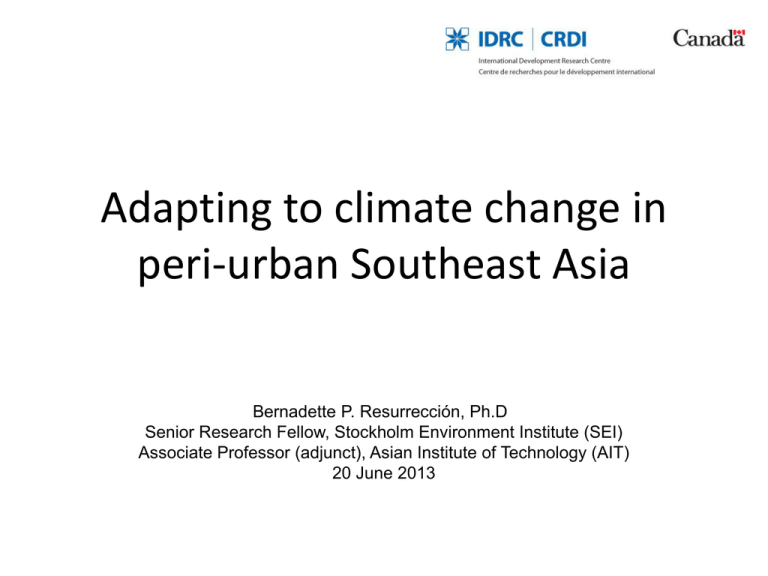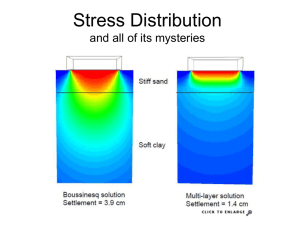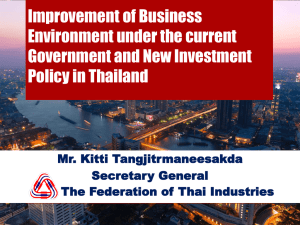Adapting to climate change in peri-urban Southeast
advertisement

Adapting to climate change in peri-urban Southeast Asia Bernadette P. Resurrección, Ph.D Senior Research Fellow, Stockholm Environment Institute (SEI) Associate Professor (adjunct), Asian Institute of Technology (AIT) 20 June 2013 Overview • Peri-urbanization in Thailand, Vietnam and Philippines indicate: – Densifying settlements in coastal, riverside or lakeside low lying area or EMRs (Externded Metropolitan Regions) due to expanding craft enterprises, real estate development, theme parks, and industrial estates – Mixed and competing uses of land and water – Specific water stress drivers: under-developed water infrastructures for supply and sanitation, weak drainage and increasing pollution, conversion of floodplains or catchment areas – Mixed settlements of well-off gated communities with poor communities of inmigrants in ecologically fragile and poorly planned zones – Weak governance institutions for social protection and managing water stresses – Low lying deltaic, catchment and coastal zones • • Manifestations of climate change: higher levels of precipitation, longer dry spells and increasing droughts Existing and differentiated socio-economic, gender-related and political vulnerabilities of periurban populations Knowledge gap: need to understand mutually reinforcing dynamics between climate change effects, socially-differentiated vulnerabilities, and peri-urban related water stresses that combine to affect people’s capacity to adapt to these stresses in their livelihoods and everyday lives Objectives (2012-2015) Research Identify the drivers of vulnerability of women and men to climate-related water stresses in three selected peri-urban case study areas in Vietnam, Thailand and the Philippines Understand their adaptive responses to these stresses in order to better inform responsive and inclusive local planning Professional Development Build research capacities of urban development professionals to identify and analyze drivers and contexts of vulnerability to climate-related water stresses in periurban that inform future planning Develop technical capacities of urban development professionals through involvement in a Work-Based (WB) Executive Masters Program with stress on applications and problem solving learning Canal Canal settlement settlement in in Pathumthani, Pathumthani, Thailand Thailand Study sites THAILAND: Krachang, Samkhok District, Pathumthani Province, Thailand (water pollution; water scarcity; flooding) VIETNAM: Van Mon Commune, Yen Phong district, Bac Ninh Province, Vietnam (surface water pollution, flooding) Criteria for study sites: 1. 2. 3. 4. The localities have to show evidence of the key peri-urban features as defined in the literature review; The choice of study site should attempt to capture a diversity of formal and informal water and sanitation institutional arrangements; The selected study sites should be home to a significant number of low-income, informal, and poor households, in order to gain a better understanding of the specific adaptive strategies and practices employed by poor women and men. If possible the study sites are located in low lying areas (floodplains, deltas, coastal areas, river basins, lakeside areas) PHILIPPINES: Sta Rosa, Laguna, (Water scarcity and flooding) Theoretical framework: A political ecology approach Multiple and dynamic drivers of vulnerability of individuals, households and communities (1) · · · · · · · · · Poverty Weak resource access and control Market fluctuations Political excl usion Historical/spatial marginalization of the peri urban Climate variability Poor infrastructure Gendered marginalization, hierarchies and social biases Weak governance, social protection, and policy mismatches between scales Specific Impacts: (2) Increase people’s risks and sensitivity to: Adaptation strategies (3) (actions to adjust, live with, anticipate, cope with water stresses) May constrain and serve as barriers to: May reproduce or reduce earlier vulnerabilities Climate-related water stresses · Water shortages · Poor sanitation · Poor, toxic water quality at different temporal, spatial and institutional scales Outcomes of adaptation strategies (4): · Reduce vulnerability (short-term or longterm) · Reproduce vulnerabilities · Create chains of vulnerabilities · Shifting of vulnerabilities to oth er spaces and groups · Pathways for synergies among local groups and institutions Methods Phase 1: Scoping (Months 1-11) 1. 2. 3. 4. 5. 6. Preliminary information and scoping on history of water stresses, interventions, hydrological and ecological conditions, climate changes Area mapping of peri-urban water stress study sites Socio-economic profiling of households in most severely waterstressed sites through rapid assessment Survey on climate change perceptions Government and non-government infrastructure and programs in place related to water stress Preliminary gender analysis of livelihoods, water use and management Slicing recycled metal strips in Van Mon District, Vietnam Phase 2: Investigating vulnerabilities and adaptation (Months 12-24) 6. Vulnerabilities and adaptation strategies (i) Typologizing and investigating patterns of experienced impacts and vulnerabilities to water stresses based on episode/s reconstruction with gender analysis; (ii) Typologizing and investigating patterns of actualized adaptation strategies to water stresses and their enabling factors and barriers based on episode/s reconstruction with gender analysis; (iii) Household survey – to test pervasiveness of qualitative results on vulnerability and adaptation with gender-disaggregated data collection 7. Assessing institutionally-organized and supported adaptation programs and actions with gender analysis Early results: Pathumthani, Thailand • • • • Climate: Higher precipitation by 10-20% (ONEP, 2011) Peri-urban characteristics: From 10% in 1985 to 30% population increase in 2000; increased competition for water use; housing projects from 114 projects in 1994 to 803 in 2008 concentrated on highways and canal areas; mixed land use results in use of water canals as wastewater sinks; weak wastewater treatment capacity People in study sites: Mostly factory laborers and small entrepreneurs; respondents are 42 female heads of HHs and 66 male heads of HHs; 15% earning less than 150US$ monthly Water stresses: (i) excessive water: seasonal flooding mediated by flood management schemes, decrease of wetlands for flood catchment due to changed land use and extreme flooding (2011); (ii) use of polluted canal water for households Flood sluice gate, Pathumthani, Thailand Early results: Van Mon Commune, Bach Ninh Province, Vietnam • Climate: Average surface temperature has risen 0.7°C since 1950; typhoon and flood seasons are longer; storms are tracking into new coastal areas; longer dry spells (Chaudhry and Ruysschaert 2007, Carew-Reid, 2008; ISPONRE 2009, Ho Long Phi, 2008) • Peri-urban characteristics: Mixed land use: 38% non agricultural- 53% agricultural; weak capacity in wastewater management; high density • People in study sites: Livelihoods are mainly agriculture and artisanal production (metal melting); 1500 HHs out of which 3000 people engage in artisanal production; majority are middle-income households due to metal melting • Water stresses: Waste water discharges from home-based craft industries to canals and public ponds during floods; Seepage from solid waste dumps during floods; scarcity of clean water from ground water boreholes plus lowering of groundwater levels, and weak operation of newly built filtered water system Very simple water filtering system developed by a poor household in Man Xa village Early results: Sta Rosa, Laguna, Philippines • • • • Climate: Longer dry spells and higher incidence of flooding Peri-urban characteristics: expanding industrial complexes and gated communities and their associated high-end malls replacing agricultural land; local government unable to monitor the extraction behavior of the private local water service provider, the massive extraction of water by the independent users having their own deep wells are unfortunately not monitored People in the study sites: a large resettlement community of urban poor migrants from Mega Manila; mostly laborers in construction and industrial estates Water stresses: Scarcity of water supply in all of the studied villages; Mix of formal and informal water-distribution institutions relying solely on deep-well drillings; private local water service provider supplies the middle and lower classes; gated communities, high-end malls and industrial complexes have their own independent deep wells and distribution systems Early results Work-based MSc Professional Development Program •Identification of embedded researchers scholars from local government units in the research component •Completed partnership agreement between the regular school (SERD) and center for professional development (AIT Extension) on the launching of the study program as a joint-venture •Completed curriculum on water and climate adaptation •Signing of MoA with Thailand’s Pollution Control Department (PCD-MONRE) for joint promotion of program (March 2013) •Result: Fund raising by PCD-MONRE for scholarships from the private business sector •Initial promotion and dissemination in Philippines, Vietnam, Thailand, Myanmar •Result: Cooperation commitment and planning for sponsoring (through matching fund) or raising funds for sending scholars to the Program: Department of Local Government (Philippines); Pollution Control Department (Thailand); Hochiminh City Environment Office (Vietnam); two city urban service agencies in Yangon, Myanmar; •First cohort in January 2014; Second cohort in January 2015 Implications Conceptual: (contributions to the sub-field of political ecology) •Gender, climate change and disaster studies: Gender dynamics to be investigated in-depth as they are embedded in experiences of climate-related water stresses employing ‘new materialisms’ in gender studies where experiences of water stresses (re)produce gender subjectivities with implications on water resiliencebuilding efforts this undermines popular ideas that women are essentially vulnerable to climate stressors •Peri-urban studies (human geography): Peri-urban conditions and their gendering and social stratifying effects on lives and livelihood options that question neo-liberal growth policies •Exacerbating effects of climate change on already existing weak institutional, economic and social conditions Methodological: •Inclusion of local government representatives into the research: what worked? What didn’t work? How can we improve vulnerability and adaptation research that translates into programming (science/research-policy nexus)?; multi-scalar approaches? •Useful approaches to investigate the workings of gender in water stress contexts (how can we improve on existing gender/vulnerability and adaptation approaches?) Programming for policy/capacity building: •‘Gender mainstreaming’ and gender planning in adaptation programming – debunking old but taking new pathways? •Groundwork for gender- and socially responsive adaptation hubs •Sensitivity to outcomes of adaptation and the possible emergence of ‘chains of vulnerabilities’ •Less of a climate-centric approach to programming, inclusion of social protection measures and development approaches •New MSc graduates from the professional work-based program and the research component PARTNERS Asian Institute of Technology, Thailand: Dr Edsel Sajor, Dr Rutmanee Ongsakul Centre for Research and Environmental Studies (CRES), Vietnam National University, Hanoi: Dr Le Thi Van Hue Social Development Research Centre, De La Salle University, Manila: Dr Antonio Contreras (Assistant Secretary, Department of Environment & Natural Resources)




